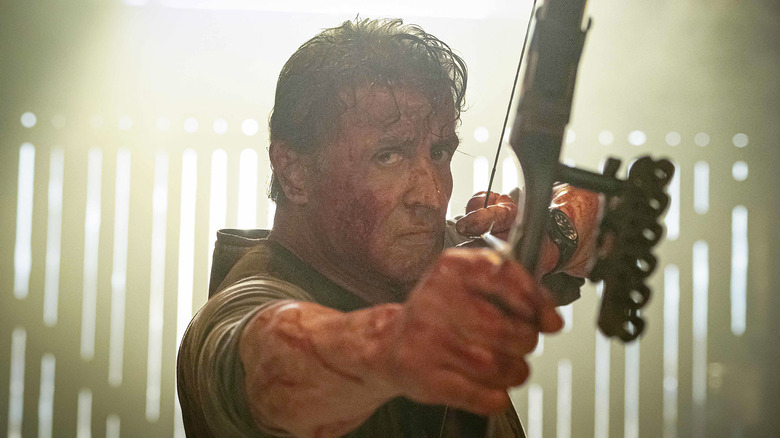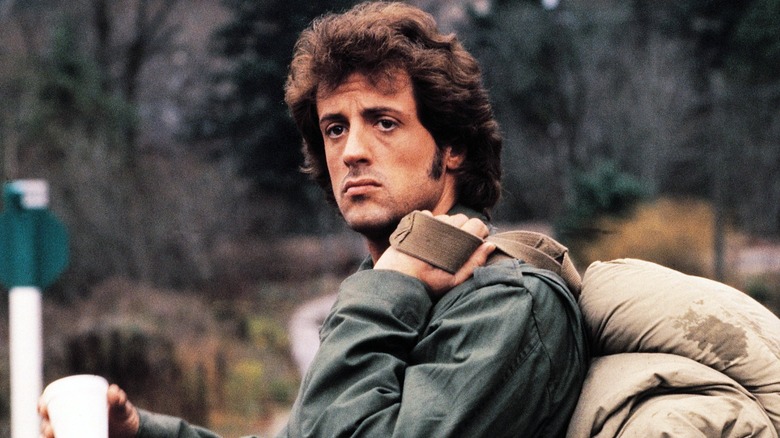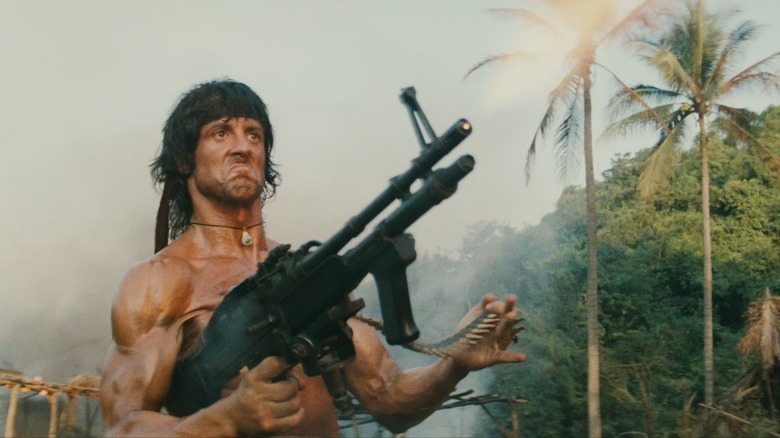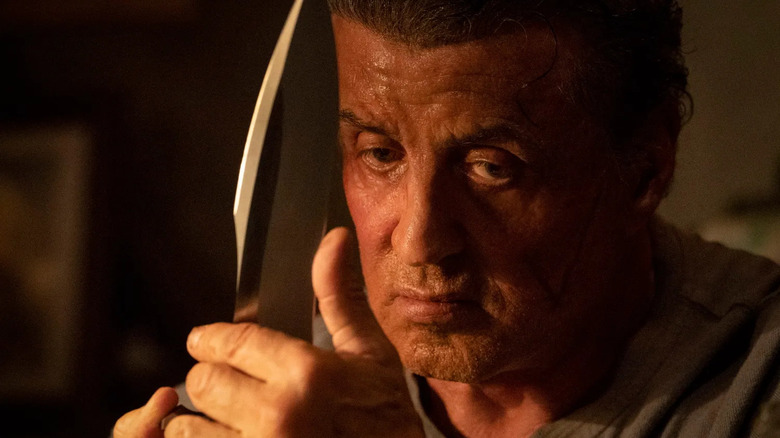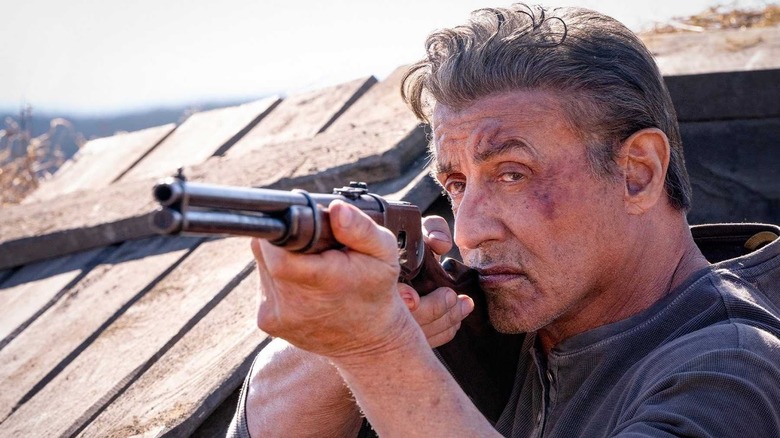Rambo: Last Blood Ending Explained: Rambo Comes Home
Adrian Grünberg's 2019 film "Rambo: Last Blood" brings John Rambo's story to a very weird, very bad end. "Last Blood," the fifth film in the Rambo saga, ends with a bloodbath straight out of a "Saw" movie, wherein the film's eponymous soldier (Sylvester Stallone) lures an army of Mexican criminals into the catacombs under his home where he cuts off their feet, decapitates them, and removes their still-beating hearts with his bare hands. His extreme acts of violence are resented as morally permissible, however, as the Mexican characters are both faceless and uniformly evil drug dealers and human traffickers.
The skewed law of morality that applies to John Rambo in "Last Blood" is very similar to the moral truth that surrounds Bugs Bunny. If you are a cartoonishly evil, unrealistic villain, and you dare to abuse or insult Bugs Bunny just once, Bugs Bunny immediately has the moral license to abuse you in return tenfold. Ever since "Rambo: First Blood Part II," the title character has, essentially, become Bugs Bunny; that is: just as unkillable and often seen facing off against foreign "bad guys" that have no real bearing on reality. If the function of a Rambo film is to witness our hero commit acts of horrendous military brutality — and, importantly, to cheer while he does it — then the filmmakers have to make darn sure the audience hates the bad guys way more than they hate Rambo.
For jingoistic, military fetishist gorehounds, "Last Blood" is first-rate entertainment. For anyone with a taste for good movies, "Last Blood" will most certainly disappoint. The ending of "Last Blood" is even more tragic when one considers the arc of John Rambo, tracing him back to his first appearance in Ted Kotcheff's "First Blood" in 1982.
The origin of John Rambo
Given the popular image of Rambo as a sweaty, over-muscled symbol for the overbearing power of American military might, it's almost shocking to remember how downbeat and antiwar "First Blood" was. In Kotcheff's film, Rambo, a Vietnam veteran, drifts into a small Washington looking for a friend he served with. He learns that his friend died of cancer after exposure to Agent Orange. Before Rambo can drift on with his sad existence, he is accosted by the local sheriff (Brian Dennehy) who gives him grief for, essentially, looking like a bum. The police continue to harass Rambo, making a clear comment on how badly veterans were treated after Vietnam.
Rambo is arrested, and his harassment at the hands of the police ends up triggering some pretty severe post-traumatic stress, causing him to snap back into "soldier mode," seeing the police as enemy combatants. A large portion of "First Blood" is devoted to a standoff between Rambo and the police, with Richard Crenna appearing to explain that Rambo is very dangerous and that triggering his flight response will cause him to commit murder.
Rambo's story is a tragic one. He was trained to kill, only to be erased and traumatized by war. Now, back in civilization, he has no applicable skills. All he knows how to do is murder, to hunt, to be a soldier. After a tragic, futile quagmire like the Vietnam War, what place does a former killing machine have? At the end of "First Blood," Rambo turns himself in before he kills a man. Presumably, Rambo will now go through the careful process of deprogramming.
The new and improved John Rambo
When George P. Cosmatos' "Rambo: First Blood Part II" was released in May of 1985, the world seemed to have changed, dividing its attention when it came to war movies. Now fully embroiled in the Cold War, Reagan's America now seemed torn between examining the losses of Vietnam ("Platoon," "Born on the Fourth of July," "Casualties of War," "Full Metal Jacket"), and bolstering American soldiers as, more or less, invincible superheroes ("Red Dawn," "Top Gun," "Iron Eagle," "The Delta Force," "Commando," and the second and third Rambo movies). The first "First Blood" was certainly a film of the former ethos, while all its sequels come from the latter.
Rambo was no longer a tragic figure, but an unstoppable badass. He evolved into the face of overwhelming firepower, and his skills are now something that the government can employ to aid in military operations. The story of "Part II" is that Rambo is needed to go back to Vietnam to rescue several American POWs still being held captive. While it seems like a straightforward mission, symbolically, "Part II" is a story about how America needs to go back to Vietnam, but win the war this time. "Part II" is a military fantasy constructed for warmongers with wounded pride. PTSD is not just something that can be shaken off, but an honest-to-goodness superpower that allows soldiers to commit the necessary amount of violence.
Peter MacDonald's frustratingly titled "Rambo III" was released in 1988, and once again, John Rambo is an unstoppable badass, his tragic origin long behind him. In "Rambo III," John is hired to, essentially, singlehandedly defeat Russia in the Cold War. In a plot point that hasn't aged well, Rambo's mission is to supply the Mujahideen with weapons. When the Cold War ended, and the 1990s brought a time of relative peace for the United States, characters like Rambo became moribund, their military prowess no longer needed.
Last Blood
Overall, Rambo has reflected the world he lives in. In the early 1980s, he was used as a symbol for PTSD. Throughout the rest of the decade, he was employed to prove how powerful the American military could be, and the 2008 film "Rambo," released during the George W. Bush administration, seemed to have an unusual target for its military ire, using Rambo's superpowers to confront the military junta in Burma rather than take on the more obvious and complex targets often discussed during War on Terror.
"Last Blood" came out during the Donald Trump administration, and it certainly shows. Tapping into the Reagan era's military glory days, "Last Blood" instead turns to Mexico for its bad guys. Not the Mexican government, mind you, but off-the-rack (and more than a little bit racist) Mexican movie villains who abuse women, sell drugs, and are generally awful and personality-free. Given the Trump administration's aversion to the country of Mexico — the president sought to build a wall along the southern border — "Last Blood" appears to be playing into the worst fears that the president communicated about it; recall Trump's speech about how "they're not sending their best people," tapping into the xenophobic fears of the American public.
In the world of "Last Blood," John Rambo — at least at first — seems to have found peace on a small farm in Arizona. In his spare time, however, he has been digging an enormous network of booby-trapped tunnels under his property, no doubt because he knows a movie climax is coming. When the teenage daughter of his business partner treks into Mexico to find her biological father, she is immediately kidnapped by an evil drug cartel and sold into sexual slavery. It will be up to Rambo to go to Mexico to provoke the cartel (he'll decapitate someone) and draw them to his death tunnels.
Filming Mexico
"Last Blood" was shot in Bulgaria, the Canary Islands, and in Shreveport, LA, using those locales as stand-ins for Mexico. In "Last Blood," Mexico is depicted as overrun with crime, run-down, impoverished, and generally crummy. The film's lighting and color timing changes when Rambo crosses the border. Indeed, there is a common photographic trick that American films employ when filming Mexican exteriors, often making the country look greenish or a smoggy brown. Various websites have compiled visual juxtapositions to demonstrate this habit. This is not the essay to fully explore the way Mexico has been depicted in American cinema throughout history, but know that "Rambo: Last Blood" is a great place to find all of the worst trends on display.
The final scenes are, as mentioned above, an utter bloodbath wherein our proud American soldier — now in his 70s — can ply his violent skills one last time before he dies. Not only is "Last Blood" tapping into violent, racist fantasies, but its function as an "old guys still got it" narrative is downright embarrassing. "Rambo: Last Blood" has the same ideas and themes as a dunderheaded comedy film like "Old Dogs."
Rambo is not obsolete, "Last Blood" argues, as long as there are non-Americans we hate enough to want to kill. Despite being named after Arthur Rimbaud, there is no poetry in Rambo's world. No irony. No self-awareness. Just the righteous assurance that might makes right and violence solves problems. Rambo's death at the end of "Last Blood" sees him slumping, exhausted, into a rocking chair, comforted that his violence was worth it. What a strange and sad end for a character marked by PTSD.
